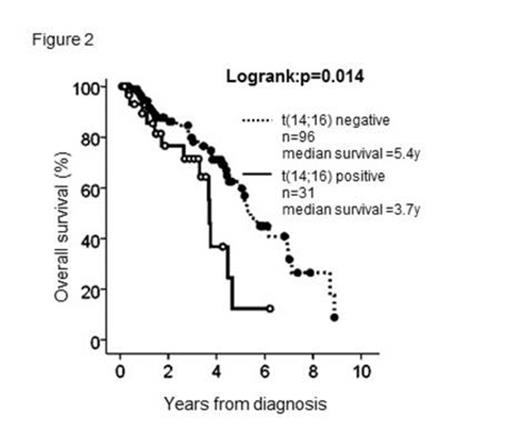Abstract
Introduction
Multiple myeloma (MM) is an incurable plasma cell neoplasm developing through long-term multistep genetic events. Biological and clinical features of the MM are known to be associated in part with relatively early genetic aberrations such as chromosomal translocations involving IGH. The t(14;16)(q32;q23) involving c-MAF oncogene locus is an important chromosomal aberration observed in approximately 5 percent of newly diagnosed MM. Various studies have suggested that MM carrying t(14;16) is associated with specific clinical characteristics. However, these studies were not definitive, since the number of the patients analyzed was relatively small. The aim of this study is to clarify the clinical features of patients with newly diagnosed MM harboring t(14;16) detected by double-color fluorescence in situ hybridization (FISH) in Japan.
Methods
Clinical and laboratory features of t(14;16)-positive MM diagnosed between 2002 and 2013 were collected retrospectively as a nationwide study in Japan after approval by each institutional ethical committee. The t(14;16) translocation was detected by FISH analysis using bone marrow or peripheral blood samples from all patients. Expression of surface antigens such as CD56 and CD20 was detected by flow cytometric analysis (FCM) and defined as positive when more than 20% of the CD38-positive plasma cells were positive.
To compare t(14;16)-positive and t(14;16)-negative MM, we also assessed 132 patients with newly diagnosed symptomatic MM and without c-MAF mRNA expression, as confirmed by global RQ/RT-PCR using purified plasma cells (Tajima E, et al.:Haematologica 2005; 90: 559, Inagaki A et al.: Leuk Res 2013; 37: 1648) at Nagoya City University Hospital.
Results
In total, 37 patients carrying t(14;16)-positive MM were enrolled from 19 institutions. Median ages of the MM patients with or without t(14;16) at diagnosis were 62 and 68, respectively. Regarding the cell surface phenotype, none of the t(14;16)-positive MM cells was positive for CD56 (Fig. 1), whereas 82 of 118 (69%) t(14;16)-negative ones were positive. Positivity for CD20 antigen was more common in t(14;16)-positive MM cells (11/23, 48%) than in t(14;16)-negative ones (16/115, 14%)(p= 0.001). The proportion of patients with additional chromosome aberrations other than t(14;16), determined by G-banded karyotyping, was higher in patients with t(14;16) (16/30, 53%) than in those without (19/131 cases, 15%) (p< 0.001). Moreover, MM patients with t(14;16) showed higher frequencies of IgG subtype M protein, leukocytosis (p= 0.001), thrombocytopenia (p< 0.001) and hyperproteinemia (p= 0.001), and a lower frequency of hypercalcemia (p= 0.001), compared to those without t(14;16).
Overall survival (OS) of the patients with t(14;16) was significantly shorter than that of those without t(14;16) even though the patients received one or more lines of treatment containing novel drugs such as bortezomib, thalidomide and lenalidomide (p= 0.014) (Fig. 2). Poor PS (PS ≥ 2-4), low PLT count (<100x103/ƒÊL), or high LDH levels (>1.0N) were significantly unfavorable prognostic factors for OS in patients with t(14;16)-positive MM, whereas they were not in those without t(14;16). Progression-free survival (PFS) of the patients with t(14;16) was also significantly shorter than those without t(14;16) (p= 0.002)
Conclusion
The t(14;16)-positive MM comprises a specific category in MM, which is featured by negativity for CD56, higher positivity for CD20 and unfavorable outcome, even in the novel drug era. Unraveling biological characteristics of this specific disease category will lead us to establish novel treatment strategies.
No relevant conflicts of interest to declare.
Author notes
Asterisk with author names denotes non-ASH members.



This feature is available to Subscribers Only
Sign In or Create an Account Close Modal